We are developing the social individualist meta-context for the future. From the very serious to the extremely frivolous... lets see what is on the mind of the Samizdata people.
Samizdata, derived from Samizdat /n. - a system of clandestine publication of banned literature in the USSR [Russ.,= self-publishing house]
|
“Spectacular City – Photographing the Future”. Photographic exhibition at the Netherlands Architecture Institute, Rotterdam, until January 7, 2007, and then touring, to the NRW Forum in Dusseldorf and subsequently to further venues.
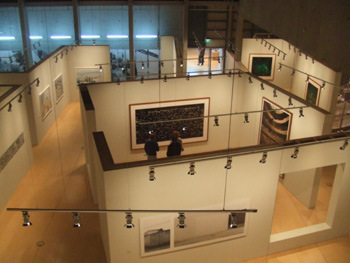
One of the great things about the internet is that it is possible to start on a familiar blog, and end up not much later at somewhere you would not have imagined being a couple of links before. And sometimes, the virtual world gets left behind, and you end up somewhere in reality you weren’t expecting to be.
For instance, on Tuesday of the week before last, I started at the blog of Willam Gibson (the famous William Gibson), and before I knew it I was simultaneously at the delightful Japan Probe and the website of the Netherlands Architecture Institute, which was apparently featuring an exhibition entitled “Spectacular City”, which was a phtographic exhibition of modern urban buildings, supposedly attempting to reveal things about cities through photographs of their less observed details. The blogged photograph on the immediate link, the Ministry of Transportation in Tbilisi in Georgia, made the exhibition look promising, especially given that I enjoy looking at modern uses of Soviet architecture at least as much as the next guy.
As I am also someone who loves few things as much as visiting suburban shopping malls, housing estates, and transport infrastructure in foreign cities, I was intrigued. I checked the location of the architecture institute in question, and was gratified to discover that it was not in Amsterdam but in Rotterdam. This is a fitting place for it. In the sense of modern architecture, Rotterdam is one of the more interesting cities in Western Europe, although one or two Spanish cities have been making a good claims recently. The combination of a city completely flattened by bombing, and a lack of the architectural timidity of London or the pomposity of Paris (and the perhaps not coincidental fact that Rotterdam post war became one of the key points of European transport infrastructure – more on that in my next post) led to a really interesting, experimental, and modern (in the best sense) city being created.
However, the real reason I was gratified was that it meant that the exhibition was relatively easy for me to visit. By a strange coincidence, I was planning on being in Antwerp a few days later, in order to go to the slightly naff Belgian/Dutch/German version of Night of the Proms, which is somewhat less musically rarified and much more poppified than the British version, but is none the less rather good fun. That took me up to Saturday night, and my train ticket back to London was for Sunday evening. My plans had been to spend most of Sunday pottering around in Antwerp – a nice city for it – but Rotterdam is only an hour north by train, and there was nothing stopping me from nipping up to Rotterdam on Sunday and having a look for myself.
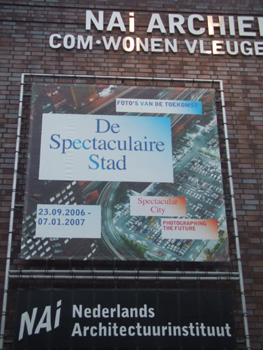
(Quick summary of the Belgian Night of the Proms: given that Tears for Fears were a band with two strong vocalists who wrote and performed somewhat overblown songs with a huge instrumental backing, they are never going to be better than accompanied by a full orchestra, a 40 strong choir on the back of the stage, three aesthetically pleasing front of the stage backing singers, and assorted drummers, pianists, and other musicians. Given also that there are a band whose repertoire really only consists of three really good songs and about four or five good ones, not terribly much is lost through their sharing a bill with other performers. On the other hand Texas are a group of slightly more musically sparse Glaswegians, and are probably better by themselves with a full set: more songs, less embellishment, and fewer distractions. Also, when they were performing the three aesthetically pleasing backup singers had changed into the most interesting of their thirty seven different costumes for the evening: outfits consisting of rather tight jeans and red corsety things that were probably illegal in Korea until recently. Male weakness meant that I was distracted. But none the less, it was a fun evening. It may not have been as fun if it had been in London, but Belgium was the right place for it).
In any event, architecture. Rotterdam. If you are a building, being the Netherlands Architecture Institute is probably like being the Vienna Philharmonic if you are an orchestra. Everybody expects you to be the Vienna Philharmonic. This is probably a bit much on an evening when you have been to the pub and have had one too many. And the NAI is a decent building trying a bit hard, but nothing really special.
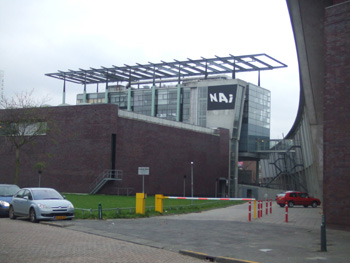
Walking into the building and into the exhibition the first thing I saw was an aerial photograph of Paris inside the Periphique: the Eiffel Tower, the wide Boulevards designed by Baron von Haussman, practically picture postcard stuff
.
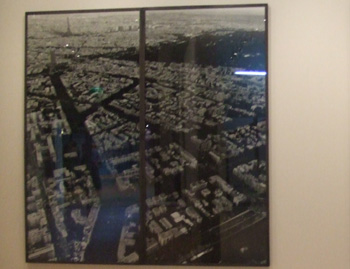
I steeled myself for disappointment with respect to the exhibit. Paris inside the Periphique is not a city that has grown from its lesser observed pieces. Paris inside the Periphique is a city in a corset, almost literally, although in this instance of a kind legal (and probably fairly common) in Korea. The city is full of legally protected buildings, height restrictions, prohibitions on selling newspapers in cafes, and worst of all, buildings owned and designed by governments. There is modern architecture, but it is monumental and government sanctioned. The city boundary corresponds with the aforementioned Periphique, an elevated motorway that surrounds the city, seemingly holding the picture postcard Paris within. The City is just a museum – it is full of governent but does not seem to have any sort of functional wealth generating economy within. It is beautiful, but it isn’t interesting.
Paris outside the Periphique is much more interesting. → Continue reading: In between
Not the baby, but the luggage.
– A Danish airport security person yesterday, explaining to a passenger what did and what did not need to go through the X-Ray machine.
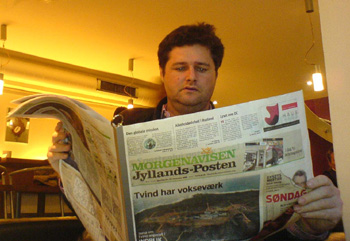
No, I cannot actually read Danish
Yesterday morning, I strugged to get out of bed after the Friday Samizdata party, caught the train to Stansted airport, caught the early flight to Aarhus in Denmark, caught the bus into town, took lots and lots of photos for a large Samizdata posting, and then checked in to my hotel. Wifi was provided in the lobby but not in the rooms. Oh well, good enough. (The group of intense looking young men crouching round a laptop and speaking Russian at the table in the lobby closest to a power outlet does add to the atmosphere, but also makes it harder to keep my laptop charged).
However, my card reader failed to be packed in the struggle to get out of my flat yesterday morning, so I could not upload the photos for the post. My plans to elicit a “What the <expletive> is Michael doing in Denmark immediately after the Samizdata party?” reaction from the readership had failed.
No problem really – I shall just post the article in a day or two. Meanwhile, Denmark is a land of very flat countryside, nice pubs, friendly, decent and at times brave people (even if they do have a slightly worrying overenthusiasm for historical enactment), adequate coffee, and nice pubs. I am enjoying the weekend out of London.
Bonus question though. What the <expletive> is Michael doing in Denmark immediately after the Samizdata party? Kudos for anyone in the commentariat who can figure it out.
In the days before accurate timekeeping, determining your longitude was an extremely difficult task, requiring extremely accurate timekeeping. The British Admiralty expended enormous resources and considerable sums of money on the problem until it was solved by John Harrison in 1761. These days, we just turn on electronic devices and communicate with satellites.
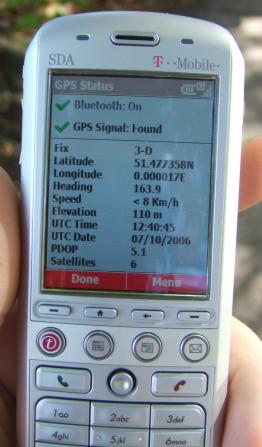
This is particularly useful when, as this afternoon, one is in a place where one couldn’t possibly discover the longitude any other way.
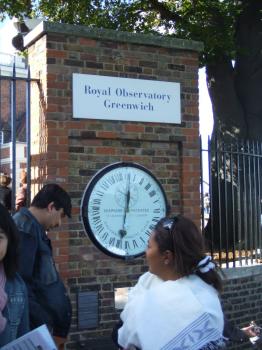
The Royal Greenwich Observatory no longer exists as an institution, having been abolished in 1998 (after moving its last astronomical faclities away from Greenwich in 1957), and the observatory buildings are today part of the National Maritime Museum, which has its main facilities in the former Greenwich Hospital buildings at the bottom of the hill below the observatory. I provide a picture merely because the view is nice.
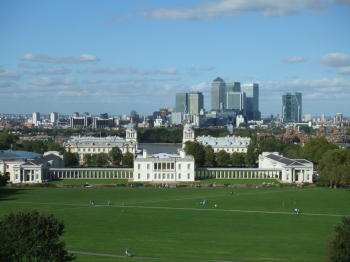
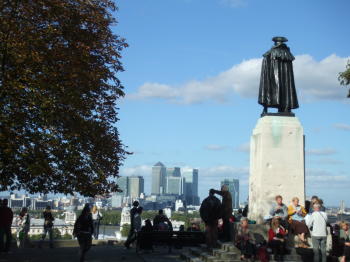
Alas, the statue at the top of the hill does not seem right. The statue is of General James Wolfe, who captured Quebec City for the British in 1754. Whilst I do not begrudge Gen. Wolfe his statue, it seems wrong, for two reasons. Firstly, why is the statue in pride of place in Greenwich, a place of great maritime heritage, a General rather than an Admiral. Secondly, given the history of the place, there is another figure who to me should be the man standing there. → Continue reading: Satellite navigation is a wonderful thing
“Purchaser shall not sell or transfer any Cat purchased hereunder to anyone other than an immediate family member, and shall not offer to any person the purchase of a Cat or any genetic material from a Cat, the rights Purchaser may have under this Agreement, or any other right related hereto, without the Company’s express written authorization.”
– An extract from the click through licence one is required to agree to when ordering a genetically modified hypoallergenic cat from a company named Allerca. (Via Boingboing).
As did many many countries, Australia prior to the 1980s had a state owned telecommunications monopoly. This company, part of the Post Office until 1976, after that named Telecom Australia and now named Telstra Corporation, charged too much, took several months to connect new telephone lines, and was generally ghastly and bureaucratic. As was also common in those days, the management of this organisation also had a rather grandiose sense of its own importance and its great civilizing and statist mission to bring telecommunications to all of the people of Australia, wherever they might be. Australia’s capital city of Canberra is a fair way inland, a long way from anything else of significance, and is full of large edifices built with taxpayers’ money. In the 1970s, Telecom decided that it needed an edifice of its own in the capital city, and Telecom Tower was built on Black Mountain (actually a not terribly large hill) overlooking Canberra.
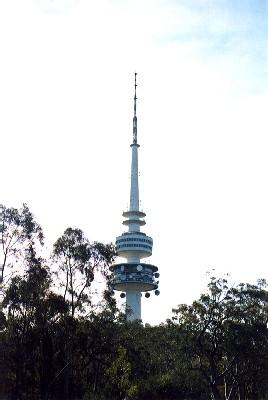 This was ostensibly a communications tower with a viewing gallery (and revolving restaurant) for admiring the view as well, but was actually a large bureaucratic organisation building a monument to its own Ozymandius like belief that it was an organisation of great permanence and importance. I last visited the tower about a decade ago, and even then it seemed a remnant from another age. There were signs talking about when and where it had been built and about the significance of telecommunications, diagrams comparing it to other structures around the world, a plaque stating it was a member of some global organisation of towers, pictures of engineers shaking hands at the groundbreaking, pictures of politicians declaring the tower open, and an extraordinary lack of humour of any kind. The word that the friend I visited it with used to describe it was ‘Soviet’, and it was hard to disagree.
Which was why it was interesting to visit another television tower a couple of weeks ago, the tower in Tallinn in Estonia. This can be seen in the distance from many parts of the city, and of course, rather than the TV tower in Australia that merely seemed Soviet, this tower actually was Soviet, so I had to see it. I knew just looking at it from a distance that this had been built as much as a symbol of Soviet domination and power as for actual telecommunications purposes, and that one way that this would be asserted would be through a viewing gallery and restaurant here, also. As I often do I was carrying a Lonely Planet guidebook. As is expected in such a guidebook, the book mentioned the TV tower by sneering at it, suggesting that the writers and readers of such a book would be much too good and much too authentic travellers to go up something as touristy as a viewing gallery in a TV tower, but we none the less have a duty to mention it in the guidebook.
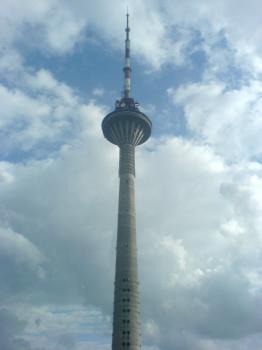 So, I caught a bus to the TV tower. When I got there I found it to be rather run down. There was an attendant at the gate collecting money, but the lift lobby was deserted and I had to push the button to be taken up myself. However, in the lower gallery were the expected signs explaining how “Expert engineers from the Moscow design bureau” had designed the tower, pictures of workers shaking hands at the groundbreaking, pompous looking bureaucrats strutting around at an opening, diagrams comparing the tower to others elsewhere, and that kind of eerily familiar thing.
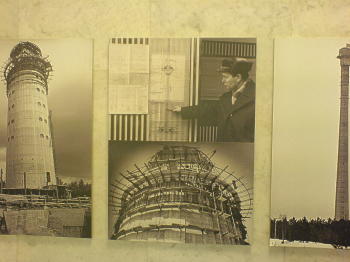 But there was something else, of course. Something much more historically interesting. → Continue reading: On telecommunications, tanks, Soviet housing estates in Estonia, and ethnically complicated shipping containers
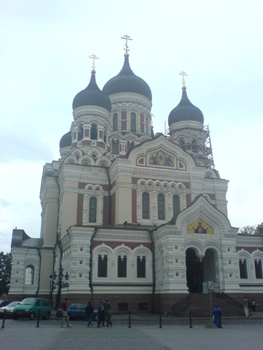
I think that this building (the Alexander Nevsky Orthodox Cathedral in Tallinn) is every bit as assertively a statement that the Russians are in charge as is the Palace of Culture in Warsaw I wrote about earlier this year. It comes from a different Russian era (the Cathedral is a Czarist structure, completed in 1900), but I think the motives for building the two structures were not too different . Certainly the Cathedral is in every bit as prominent a location as the Palace of Culture – it is on the top of the Toompea hill in Tallin’s Old Town, directly opposite Tallin castle (now the Estonian national parliament). Certainly, also, it is every but as architecturally out of character from the historical city, which in style is a typical Baltic Hanseatic League city, although the people of the city are clearly very proud of the medieval town hall
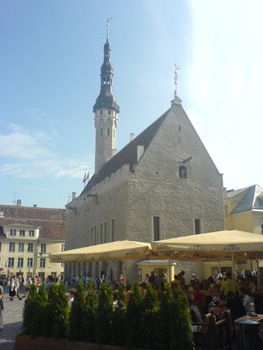
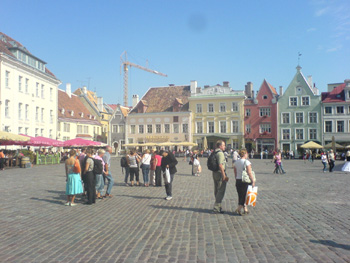
It is only six years since I was last in Tallinn, but the city certainly seems to have come a long way since then. At that point the Old Town was beautiful, but the rest of the city felt grimy when I left it. No longer. It’s not a terribly large city (half a million?) and it is not as frenetic as some larger cities, but it has the air of a place becoming, well, comfortable. Modern office buildings going up. Suburban tracts of nice, large houses being built on the waterfront to the west of town. That kind of thing. There are lots of Soviet housing estates between the old centre and the nice suburbs, but in truth I have seen worse in London. And Paris. And Amsterdam. It is difficult to believe that this was part of the Soviet Union only fifteen years ago. But it was.
And it was certainly a nice touch to be able to talk to friends in Australia using a software product that was developed here. The computer markets of China are full of people attempting to sell you cheap Skype handsets. However, Tallinn gave us Skype itself. That is worth more.
The bloody wombats were getting in over the fence. We had no idea they could climb.
– Australian farmer Bill deCorsie, complaining that local marsupials were eating his truffles. (The bigger picture behind this, which is that the Australian agricultural industry has over the last couple of decades been rapidly moving (shall we say) up the food chain from relatively low value (but high quality) basic foodstuffs to high value products largely for export is quite an interesting one).
I suppose one of the main reasons that airshows are held is that actually seeing the thing fly can temporarily remove the sense from people who in their rational moments think that an A380 or some other aircraft may not have much of a practical role, or may not be worth the money.
And as it happened, on Sunday, I was impressed by the A380, and I was again impressed by the V22 Osprey, which if nothing else can certainly put on an impressive display.
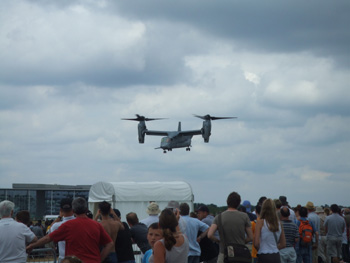
Alas, I didn’t get a good picture of it in “aeroplane mode”, but for a helicopter it was certainly quick in getting from A to B. This is the best I can do.
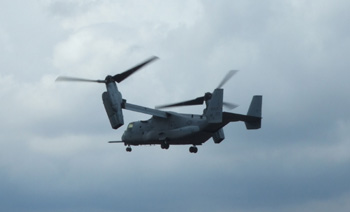
On the other hand, it is quite impressive what a proven, useful, and big helicopter can do when it only has the tiny fuel load needed for a ten minute display.
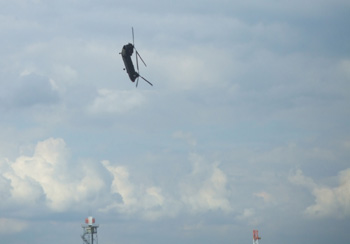
It was something of a day for the helicopters. As well as the Chinook, the RAF sent a Merlin for an aerobatic display, and this was also really impressive. Of course, there were lots and lots of jet fighters, too (the highlight of which was probably a MiG-29), but in order for photos of them to not look like a black spot in the distance, you really need a lens like this one, which I did not have.
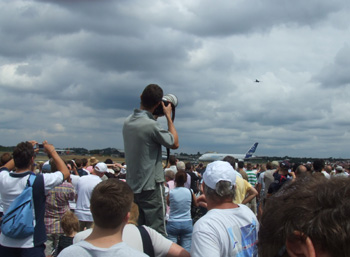
Still, I am sure Brian will give me points for the billion monkeys shot.
You simply have to look at this if you are into unaffordable jet aircraft!
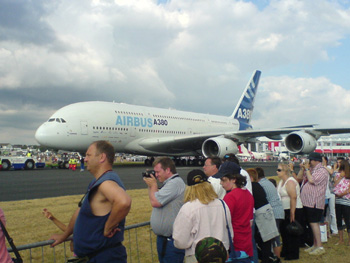
Although I have had some doubts about the financial case for the A380, it is none the less awfully impressive when you see it from up close.
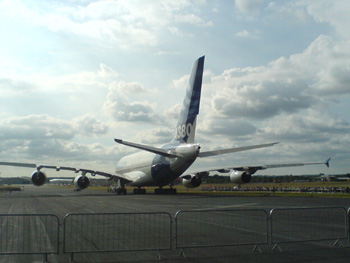
(Farnborough 2006 was splendid. More later).
The Farnborough Air Show is on near London this week. In the commercial jet market, things have changed dramatically since the Paris Air show last year. A year ago Airbus had their first flying displays of their very large new A380 airliner, and for the fifth year in a row Airbus received more orders for airliners than did Boeing. Through a combination of more modern aircraft, more modern production lines and (perhaps) state subsidies, Airbus has come from a distant position in the market to market leadership.
However, this year Airbus fallen to a distant second in the market, having received only 117 orders this year to Boeing’s 480. The A380 is behind schedule, the first airlines to receive it will be getting it six months late, and Airbus has scarcely received an order for it in the last couple of years. (Total orders are presently for 159). Boeong has received orders for 400 of its new mid-market 787 aircraft (and orders for Airbus’ A330 and smaller A340 variants have dried up completely) and is also significantly ahead of Airbus in the upper mid-market segment containing Airbus’ A340-600 aircraft and Boeing’s 777-300. Airbus’ British shareholder BAe Systems would like to sell its minority stake in Airbus, and therefore recently commissioned N. M. Rothschild to provide a valuation of the stake. The resulting valuation (€2.75bn) was dramatically less than the (€4bn) BAe Systems had anticipated.
The short term reasons for this turnaround are fairly obvious. The dollar has weakened significantly compared to the euro. While Airbus has hedged its currency exposure on existing orders and these will therefore still be profitable, it lacks this advantage going forward on new orders. While Boeing’s production methods were outdated five years ago, its logistical systems have been dramatically improved since, and in terms of production it once again can compete. The A380 delay is certainly a short term factor, but most aircraft programs feature a delay like this at some point.
But these are only the short term reasons. There are more long term reasons, but the financial press seems to have failed to put the whole story together. → Continue reading: Airbus misses a paradigm shift
My thanks to Jonathan Schwarz over at Slate for pointing out that various Islamic terrorist organisations including Hamas and Al Qaeda include of all things Rotary Clubs amongst their lists of anti-Islamic organisations that they believe are waging crusades on them. From the Hamas charter, for instance
…you can see [the enemies] making consistent efforts by way of publicity and movies, curriculi of education and culture, using as their intermediaries their craftsmen who are part of the various Zionist Organizations which take on all sorts of names and shapes such as: the Free Masons, Rotary Clubs, gangs of spies and the like. All of them are nests of saboteurs and sabotage.
My first thought is to almost wish it were true: if my local Rotary club was in fact on organisation of saboteurs fighting the Jihadis, I might almost want to join. It sounds quite exciting. My second thought, however, is I think the sort of uneasy thought that Group Captain Mandrake gets in Dr Strangelove when Gen. Ripper explains to him that he has just launched a nuclear attack on Moscow to fight fluoridation of drinking water. In this war one occasionally feels that the enemy does not need to be fought so much as it needs to be medicated, and this is one of those times.
Then again, I suppose this makes no more or less sense than blaming the Jews.
|
Who Are We? The Samizdata people are a bunch of sinister and heavily armed globalist illuminati who seek to infect the entire world with the values of personal liberty and several property. Amongst our many crimes is a sense of humour and the intermittent use of British spelling.
We are also a varied group made up of social individualists, classical liberals, whigs, libertarians, extropians, futurists, ‘Porcupines’, Karl Popper fetishists, recovering neo-conservatives, crazed Ayn Rand worshipers, over-caffeinated Virginia Postrel devotees, witty Frédéric Bastiat wannabes, cypherpunks, minarchists, kritarchists and wild-eyed anarcho-capitalists from Britain, North America, Australia and Europe.
|


















